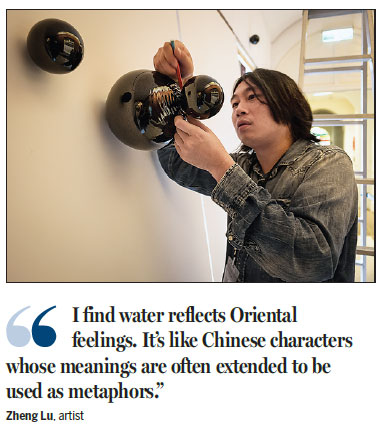Making waves with water
Updated: 2015-12-01 08:06
By Lin Qi(China Daily)
|
||||||||
Zheng Lu finds a unique source of inspiration to make his points about life and nature. Lin Qi reports.
Shiosai, the centerpiece of Zheng Lu's solo exhibition at the Museum of Contemporary Art, Taipei, is a piece of stainless steel that is in the form of billows.
The work, which is nearly 4 meters long, represents the sea - transitioning from still water to small sprays, and, finally, to huge waves that reach heights of 2 meters.
The work stuns with its effect of capturing the sea.
Zheng's work, which was produced this year, is named after a novel by prolific Japanese author Mishima Yukio (1925-70). The novel was published in 1954.
The story of Shiosai (the sound of waves) is centered on the coming-of-age romance and maturing of the protagonist, Shinji.
But Zheng's work emphasizes the transformation of water, the motif of his one-man show, also titled Shiosai, now on display at MoCA Taipei.
He also uses surging waves - a point where the installation ends - to portray the artist's dramatic life that first interested and triggered him to create the work.
"Mishima's writing style is quite feminine, delicate and picky with details. While he exercised hard to attain a masculine body shape, I'm more interested in his contradictory personality," Zheng, 37, tells China Daily in a recent interview in Beijing, where he lives and works.
"He committed suicide when he was at the top.
"It fascinates me that one would disappear when he is at the top, leaving a lot of things for people to reflect on and talk about," he says.
Zheng's show also has 15 works in varied media, which he has been working with for the past two years, including sculpture installations, lacquer painting on aluminum plates, and videos. Every piece shows him digging into the connotation and extended meaning of "water".
Zheng first addressed water as a subject in his art in 2007.
He had at the time explored the possibility of transforming 2-D Chinese characters into 3-D spatial sculptures and installations.
He used the metal technique of open-work carving to create large, irregularly shaped pieces and carved poems and verses of Chinese classics on the surfaces.
Zheng's childhood was filled with literary pursuits - he learned calligraphy from his grandfather and poetry from his father, a literature enthusiast.
When looking for meaningful writings for his works, Zheng was struck by a work of Tang Dynasty (AD 618-907) poet Bai Juyi titled Wan Zhi Shui (Reflections on Still Water).
The poem compares water with one's state of mind, and says that one should be focused and settled to know what one really wants.
"I find water reflects Oriental feelings. It's like Chinese characters whose meanings are often extended to be used as metaphors."
In his Water series he merges verses from Wan Zhi Shui with sculpture installations of beautiful sprays.
Zheng has also attempted to overcome the physical limitations of water in his creative work.
PWM Controller and Known Circle are two mixed-media works on display, which can be seen as a pair looking at the possibilities of space, says Zheng.

In PWM Controller, he uses digital coding to create artificial rainfall indoors.
The rain generated by the pumps suspended in midair fall on several groups of stainless-steel keyboards on the ground, creating rhythmic sounds.
The ripples created by the rain on the collected water are then recorded, and the images are projected by four projectors on Known Circle, a resin model of a globe suspended in midair.
Together, the two works show the infinite energy of nature.
In his works, Zheng also shows concern over overexploitation of marine life, especially endangered species.
Grave of Honor is a sculpture resembling a human's heart, which he uses to criticize greed that threatens creatures with extinction.
In it, numerous large, stainless steel fishhooks are fixed together to form the vertical section of a heart.
He uses the hooks to create a feeling of coldness and sharpness, which contrasts with the warmth and softness of a heart.
The piece was exhibited at an art show, On Sharks & Humanity, which campaigned for the protection of sharks at the National Museum of China.
That show ran from August to October.
Contact the writer at linqi@chinadaily.com.cn
|
Top left:Water in Dripping - Billows, an installation by Zheng Lu displayed at Museum of Contemporary Art in Taipei. Top right: Grave of Honor, a sculpture resembling a human heart. Above: Shiosai, the centerpiece of Zheng's solo exhibition. Photos Provided To China Daily |

(China Daily 12/01/2015 page18)
- Britain's Cameron says time to bomb militants in Syria
- Russia accept full suspension from athletics
- Turkish and Russian FMs to meet in Belgrade
- S.Korea, DPRK agree to hold vice ministers' meeting for improved ties
- Avoiding escalation over Russian warplane downing
- Rights panel presses US over scientists' cases
Most Viewed
Editor's Picks

|

|

|

|

|

|
Today's Top News
Chinese bargain hunters are changing the retail game
Chinese president arrives in Turkey for G20 summit
Islamic State claims responsibility for Paris attacks
Obama, Netanyahu at White House seek to mend US-Israel ties
China, not Canada, is top US trade partner
Tu first Chinese to win Nobel Prize in Medicine
Huntsman says Sino-US relationship needs common goals
Xi pledges $2 billion to help developing countries
US Weekly

|

|

















